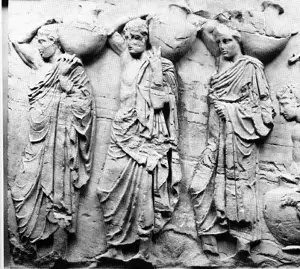Slavery in Ancient Greece
Slavery was very much a part of society in Ancient Greece. Many sources from the period and after reference the rights and responsibilities of slaves and their masters. However, the Greeks used more than one word to refer to people were enslaved, and the key to understanding was not universal or always obvious. 
Ancient sources, like Hesiod and Homer, used a term that was similar to people taken as property resulting from a victory in war. Sources from Mycenaean times (the Trojan War era) used a term similar to the English "servant" or "bondman." During what's called the Classical period, when most of the well-known people were around, the term was closer to servant or houseboy (a term used in a derogatory fashion toward adult slaves). Many slaves in Greece worked on farms and in mines and quarries. Owners of small farms might have only one or perhaps two or three slaves; owners of large farms and estates might have a few dozen slaves. The number of slaves working in the silver mines of Laurium, in Attica, has been estimated in the tens of thousands. Slaves also served in trades and crafts and around the house, as domestic "servants," doing household chores. Slaves could even run a business, as long as they gave the earnings to their master. The slave trade was in operation, between city-states and between civilizations. Another source of slaves was piracy: kidnapped who couldn't raise a ransom were sold into slavery. Slaves in Ancient Greece could marry and have a family; all were the property of the master, who had the right to split up the family if so desired. Slaves could practice their own religion. Slaves were not citizens and so could not take part in politics. A slave involved in a judicial proceeding would be represented by the master. Free people could sell themselves into slavery in order to pay off debts; when the debt was repaid, the slave could go free. Slaves were not necessarily enslaved for life. Their master could free them, a process called manumission. Slaves could buy also their freedom. Some slaves earned a little money from time to time and were allowed to set a little aside. A former slave was called a "freed person," which was not a "free person," someone who had never been enslaved. Once a person had been a slave, that fact remained with them, even long after they had gained their freedom. "Freed" people enjoyed far fewer rights than did citizens. Some estimates say that at one time, Athens had up to 80,000 slaves. Not to be left out, Sparta had large number of slaves as well, called helots. Several sources tell of helot revolts against Sparta; such uprisings were rare, however, to the point of nonexistence in Athens and other city-states. Much more common it was for a slave to escape, literally, as a great many Athenians did after Sparta's victory in the Peloponnesian War. The philosophy of the day attempted to validate slavery. Aristotle, in particular, thought that some people were born to be slaves. Greece, as with other ancient civilizations, countenance and at times even encouraged slavery. When the Roman civilization instituted many Greek customs into their own, slavery was one of them. |
|
Social Studies for Kids
copyright 2002–2024
David White




